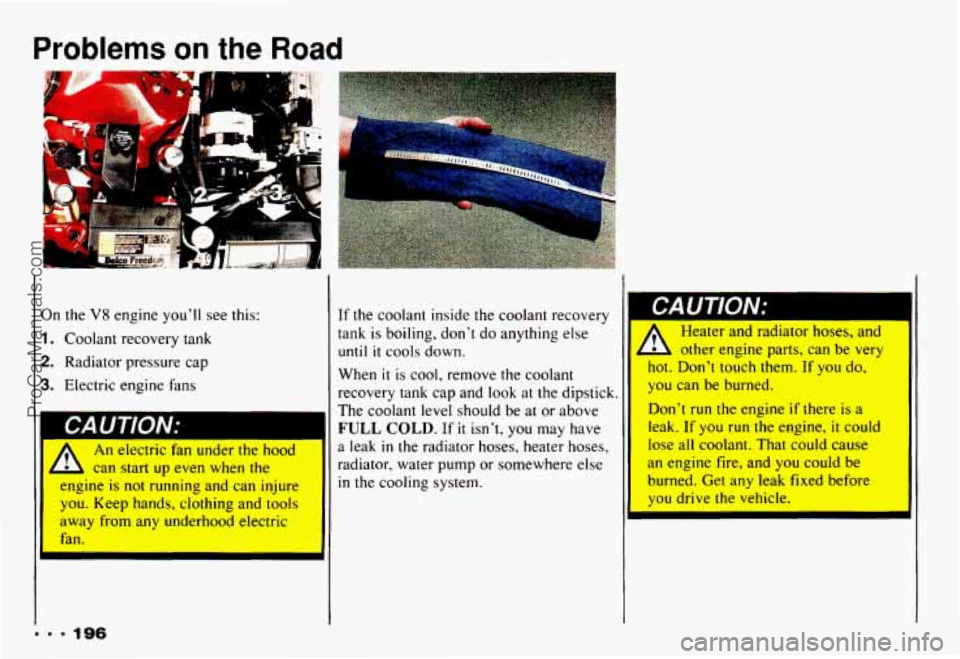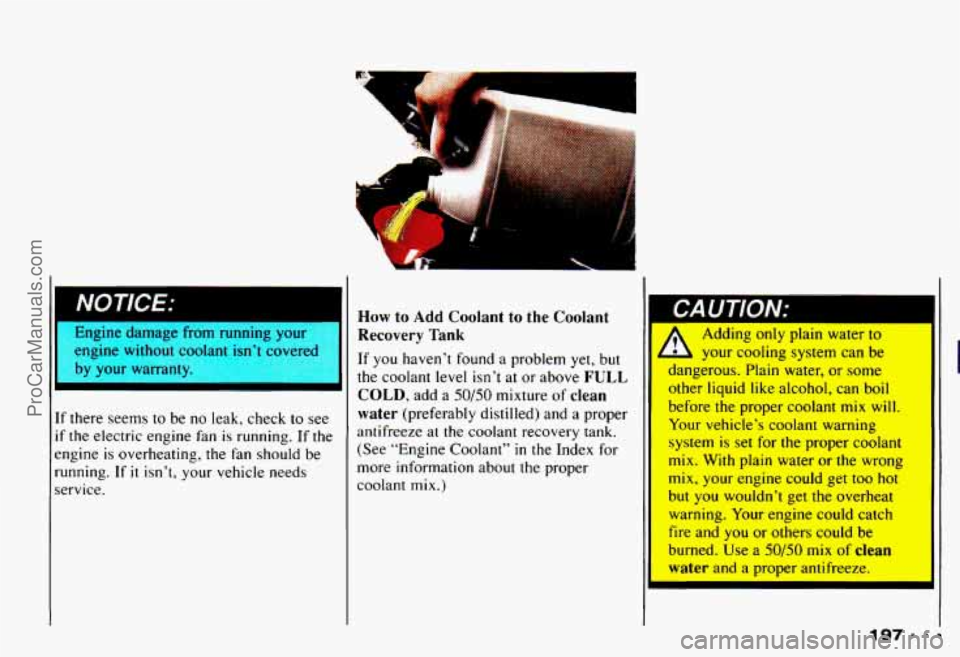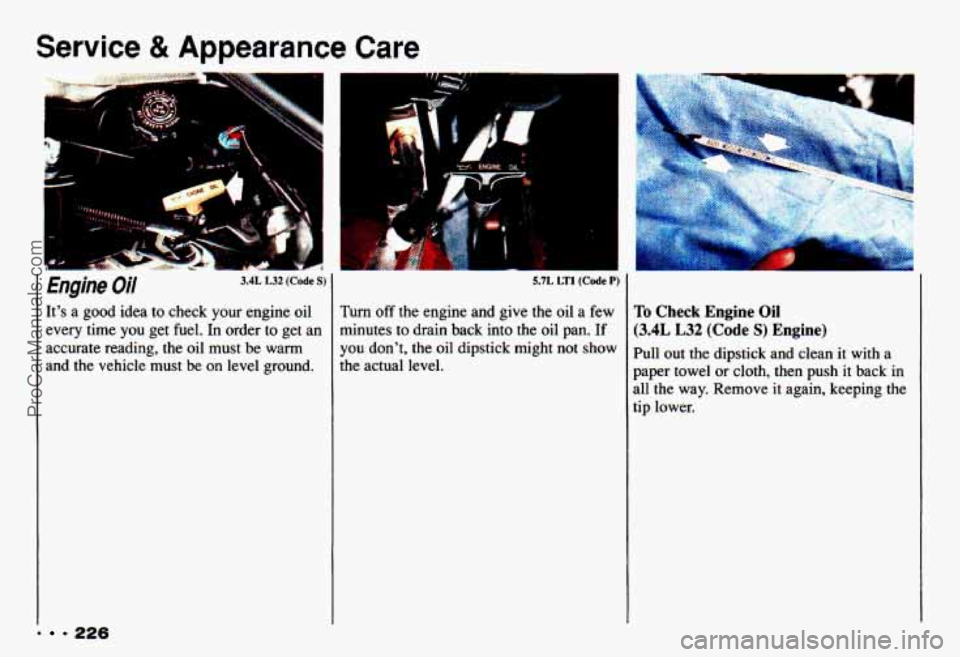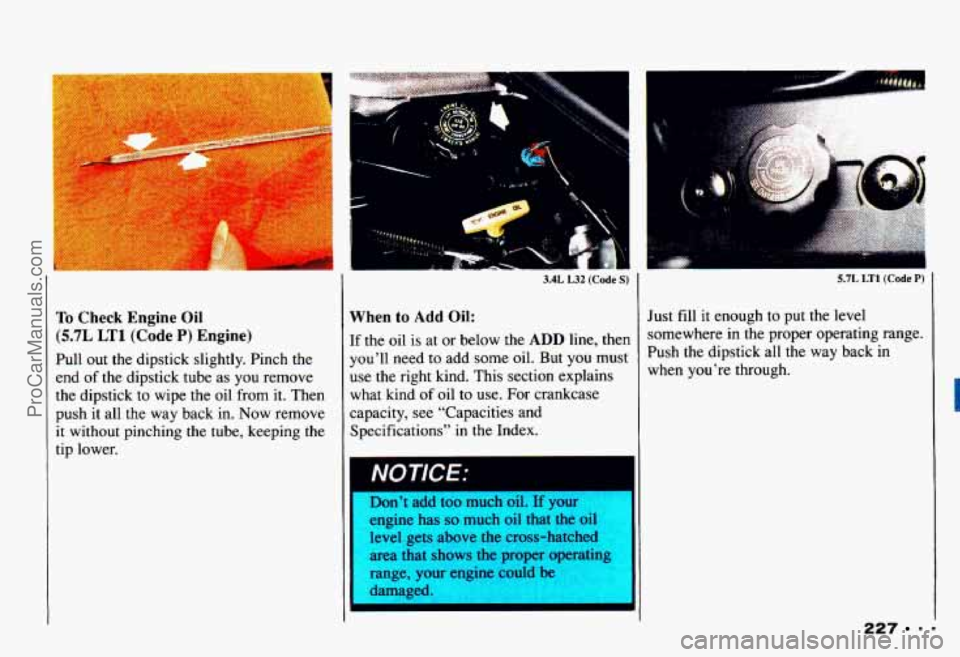1993 CHEVROLET CAMARO oil level
[x] Cancel search: oil levelPage 66 of 358

Features & Controls
I NOTICE:
I HTI~~ you-ve usea me DIOCK neater, I- sure to store the cord as it was
,-fore, to keep
it aw-f from movin
engine parts.
If you h’t ; $&add ,$a;!$$$,.
be damaged.
I
, . ,Q i ,,<.> . , t!!! h,~
I
How long should you keep the block
heater plugged in? The answer depends
on the weather, the kind of oil you have,
and some other things. Instead of trying to
list everything here, we ask
that you
contact
a Chevrolet dealer in the area
where you’ll be parking your vehicle. The
dealer can give
you the best advice for
that particular area,
... 62
Automatic
Transmission
There are several different positions for
your shift lever.
P (Park)
This locks your rear wheels. It’s the best
position to use when you start your
engine because your vehicle can’t move
easily.
It is dangerous to get out of
your vehicle
if rhe shift lever is
not fully in P (Park) with the
parking brake
firmly set. Your
vehicle can roll.
Don’t leave your vehicle when the
engine
is running unless you have
to. If you have left the engine
running, the vehicle can move
suddenly.
You or others could be
injured. To be sure your vehicle
won’t move, when you’re on fairly
level ground, always set your
parking brake and move the shift lever to
P (Park).
See “Shifting into
P (Park)” in the
Index.
If you are parking on a hill,
or if you’re pulling a trailer, also
see “Parking on Hills” or “Towing
a Trailer” in the Index.
ProCarManuals.com
Page 109 of 358

Check Gages Light
This light will come on briefly when you
are starting the engine.
If the light comes
on and stays
on while you are driving.
check your gages
to see if they are in the
warning areas.
Low Oil Light
This light should come on while you are
starting your engine.
If the light doesn’t
come on. have
it repaired. If the light
comes on while starting your engine and
stays on. your engine
oil level may be too
low. You may need to add oil. See the
Index under “Engine
Oil.“
Low Coolant Light (V8 Engine)
This light should come on while you are
starting your engine.
If the light doesn’t
come on, have
it repaired. The light also
comes on when the coolant
in your
radiator is low.
You may need to add
coolant. See
the Index under “Engine
Coolant.“
.. Drtvlng wilt Lllr uw vv wwvuIIA I’
light on could cause your Chevrolet tc
overheat. See “Engine Overheating”
in the Index. Your Chevrolet could be
damaged, and
it wouldn’t be covered
by your warranty.
ProCarManuals.com
Page 167 of 358

Driving a Long
Distance
Although most long trips today are made
on freeways, there are
still many made on
regular highways.
Long-distance driving on freeways and
regular highways
is the same in some
ways. The
trip has to be planned and the
vehicle prepared, you drive at
higher-than-city speeds, and there are
longer turns behind the wheel. You’ll
enjoy your trip more
if you and your
vehicle are
in good shape. Here are some
:ips for a successful long trip.
Before Leaving on a Long Trip
Make sure you’re ready. Try to be well
rested. If you must start when you’re not
fresh
- such as after a day’s work -
don’t plan to make too many miles that
first part of the journey. Wear comfortable
clothing and shoes you can easily drive
in.
Is your vehicle ready for a long trip? If
you keep
it serviced and maintained, it’s
ready to go. If
it needs service, have it
done before starting out. Of course, you’ll
find experienced and able service experts
in Chevrolet dealerships all across North
America. They’ll be ready and willing to
help
if you need it. Here
are some things you can check
before a trip:
0
0
0
0
0
Windshield Washer Fluid: Is the
reservoir
full? Are all windows clean
inside and outside?
Wiper Blades: Are they in good
shape?
Fuel, Engine Oil, Other Fluids:
Have you checked all levels?
Lights: Are they all working? Are the
lenses clean?
Tires: They are vitally important to a
safe, trouble-free trip.
Is the tread
good enough for long-distance
driving? Are the tires all inflated to
the recommended pressure?
163 -
ProCarManuals.com
Page 200 of 358

Problems on the Road
I. -
.. .
On the V8 engine you’ll see this:
1. Coolant recovery tank
2. Radiator pressure cap
3. Electric engine fans
An electric fan under the hood
L can start up even when the
engine
is not running and can injure
you. Keep hands, clbthing and tools
away from any underhood electric
fan.
... 196
I I
If the coolant inside the coolant recovery
tank
is boiling, don’t do anything else
until it cools down.
When
it is cool, remove the coolant
recovery tank cap and
look at the dipstick. I I
The coolant level should be at or above
FULL COLD. If it isn’t, you may have
a leak
in the radiator hoses, heater hoses,
radiator, water pump or somewhere else
in the cooling system. II
A Heater and radiator hoses, and
L other engine parts, can be very
hot. Don’t touch them.
If you do,
you can be burned. ~
Don’t run the engine if there is a
leak. If
you run the engine, it could
lose
all coolant. That could cause
an engine fire, and you could be
burned. Get any leak fixed before
you drive the vehicle.
ProCarManuals.com
Page 201 of 358

eng~ witho
r
u -.. .
tolar .-
[f there seems to be no leak, check to see
f the electric engine fan is running. If the
:ngine is overheating, the fan should be
-unning.
If it isn’t, your vehicle needs
iervice.
I I
How to Add Coolant to the Coolant
Recovery Tank
If you haven’t found a problem yet, but
the coolant level isn’t
at or above FULL
COLD,
add a 50/50 mixture of clean
water
(preferably distilled) and a proper
antifreeze at the coolant recovery tank.
(See “Engine Coolant”
in the Index for
more information about the proper
coolant
mix.)
A Adding only plain water to
L your cooling system can be
dangerous. Plain water, or some
I
other liquid like alcohol, can boil
before the proper coolant
mix will.
Your vehicle’s coolant warning
system
is set for the proper coolant
mix. With plain water or the wrong
mix, your engine could get too hot
but you wouldn’t get the overheat
warning. Your engine could catch
fire and you or others could
be
burned. Use a 50/50 mix of clean
water
and a proper antifreeze.
197-
ProCarManuals.com
Page 221 of 358

Part b
Here you will find information
about the care
of your Chevrolet .
This part begins with service and
fuel information. and then it shows
how
to check important fluid and
lubricant levels
. There is also
technical information about your
vehicle. and a section devoted to
its appearance care
.
Service & Appearance Care
Service .......................................................... 218
Fuel
............................................................ 219
Checking Things under the Hood
..................................... 223
HoodRelease
................................................... 223
Engineoil
...................................................... 226
Aircleaner
..................................................... 230
Automatic Transmission Fluid
...................................... 233
Manual Transmission Fluid
........................................ 235
Hydraulicclutch
................................................ 237
RearAxle
...................................................... 237
Enginecoolant
.................................................. 238
Power Steering Fluid
............................................. 242
Windshield Washer Fluid
.......................................... 243
Brake Master Cylinder
............................................ 244
Battery
........................................................ 246
Bulb Replacement
................................................. 247
Loading Your Vehicle
.............................................. 255
Appearance Care and Maintenance Materials
............................ 274
Vehicle Identification Number (VIN)
.................................. 275
Service Parts Identification Label
..................................... 275
Add-on Electrical Equipment
........................................ 275
Fuses and Circuit Breakers
.......................................... 276
Replacement Bulbs
................................................ 279
Capacities and Specifications
......................................... 280
Tires
............................................................ 256
Appearancecare
.................................................. 265
217
ProCarManuals.com
Page 230 of 358

Service & Appearance Care
. = 226
Engine Oil 3.4L L32 (Code S)
It's a good idea to check your engine oil
every time
you get fuel. In order to get an
accurate reading, the oil must be warm
and the vehicle must be on level ground,
5.7L LTl (Code P)
Turn off the engine and give the oil a few
minutes to drain back into the oil
pan. If
you don't, the oil dipstick might not show
the actual level.
To Check Engine Oil
(3.4L L32 (Code S) Engine)
Pull out the dipstick and clean it with a
paper towel or cloth, then push it back in
all the way. Remove it again, keeping the
tip lower.
ProCarManuals.com
Page 231 of 358

To Check Engine Oil
(5.7L LT1 (Code P) Engine)
Pull out the dipstick slightly. Pinch the
end of the dipstick tube as you remove
the dipstick to wipe the oil from it.
Then
push it all the way back in. Now remove
it without pinching the tube, keeping the
tip lower.
3.4L L32 (Code S:
When to Add Oil:
If the oil is at or below the ADD line, then
you’ll need
to add some oil. But you must
use the right kind. This section explains
what kind
of oil to use. For crankcase
capacity, see “Capacities and
Specifications” in the Index.
11 NOTICE:
UUll 1 auu LUU IIIULII u11. 11 ywul
engine has so much oil that the oil
I level gets above the cross-hatched
area that shows the proper operating
I
range, you
damaged.
I I
5.7L LT1 (Code P)
Just fill it enough to put the level
somewhere in the proper operating range.
Push the dipstick all
the way back in
when you’re through.
227 9
ProCarManuals.com